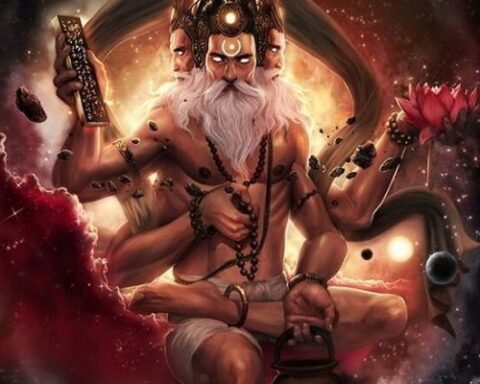Introduction
The Bhagavad Gita is a dialogue between Arjuna, a supernaturally gifted warrior and his guide and charioteer Lord Krishna on the battlefield of Kurukshetra. As both armies stand ready for the battle, the mighty warrior Arjuna, on observing the warriors on both sides becomes overwhelmed with grief and compassion due to the fear of losing his relatives and friends and the consequent sins attributed to killing his own relatives. So, he surrenders to Lord Krishna, seeking a solution. Thus, follows the wisdom of the Bhagavad Gita.
Bhagavad Gita, also known as the Gita – “The Song of God” is a practical guide to one’s life that guides one to re-organise their life, achieve inner peace and approach the Supreme (the Ultimate Reality).
The Bhagavad Gita packs an intense analysis of life, emotions and ambitions, discussion of various types of yoga, including Jnana, Bhakti, Karma and Raja, the difference between Self and the material body as well as the revelation of the Ultimate Purpose of Life.
Summary of Bhagavad Gita
The synthesis in Bhagavad Gita addresses the question as to what constitutes the virtuous path and one necessary for the spiritual liberation and a release from the cycles of rebirth (moksha). It discusses whether one should renounce a householder lifestyle for a life as an ascetic, or lead a householder life dedicated to one’s duty and profession, or pursue a householder life devoted to a personalized god in the revealed form of Krishna. Thus Gita discusses and synthesizes the three dominant trends in Hinduism: enlightenment-based renunciation, dharma-based householder life, and devotion-based theism. According to Deutsch and Dalvi, the Bhagavad Gita attempts “to forge a harmony” between these three paths.
The Bhagavad Gita’s synthetic answer recommends that one must resist the “either-or” view, and consider a “both-and” view. It states the dharmic householder can achieve the same goals as the renouncing monk through “inner renunciation”, that is “motiveless action”. One must do the right thing because one has determined that it is right, states Gita, without craving for its fruits, without worrying about the results, loss or gain. Desires, selfishness and the craving for fruits can distort one from the dharmic action and spiritual living.
The Gita synthesis goes further, according to its interpreters such as Swami Vivekananda, and the text states that there is Living God in every human being and the devoted service to this Living God in everyone – without craving for personal rewards – is a means to spiritual development and liberation. According to Galvin Flood, the teachings in Gita differ from other Indian religions that encouraged extreme austerity and self-torture of various forms (karsayanta). The Gita disapproves of these, stating that not only is it against the tradition but Krishna himself, because “Krishna dwells within all beings, in torturing the body the ascetic would be torturing him”, states Flood. Even a monk should strive for the “inner renunciation”, rather than external pretensions.
The Gita synthesizes several paths to spiritual realization based on the premise that people are born with different temperaments and tendencies (guna). According to Winthrop Sargeant, the text acknowledges that some individuals are more reflective and intellectual, some affective and engaged by their emotions, some are action-driven, yet others favour experimenting and exploring what works. It then presents different spiritual paths for each personality type respectively: the path of knowledge (jnana yoga), the path of devotion (bhakti yoga), the path of action (karma yoga), and the path of meditation (raja yoga). guna premise is a synthesis of the ideas from the Samkhya school of Hinduism.
According to Upadhyaya, the Gita states that none of these paths to spiritual realization is “intrinsically superior or inferior”, rather they “converge in one and lead to the same goal”.
Why should we read Bhagavad Gita?
Bhagavad Gita is the most quintessential literature among all Vedic compositions. This composition as compiled by the great sage Vyasadeva has been endearing to all those who seek Truth, who look for perfection, who are interested in a complete science of everything irrespective of caste, creed, religion and nationality. This holy book presents the science of life, as it is, which was originally spoken to Arjun by Lord Krishna, the Supreme Personality of Godhead in the battlefield of Mahabharata approximately 5000 years ago. Through the ages, Srimad Bhagavad Gita has inspired and guided hosts of philosophers and scientists. Its influence is not limited to India. There is not a single language in the world in which Bhagavad Gita has not been translated.
Bhagavad Gita is not the science of a particular community – it is the universal science of the soul. It is a science that compels us to embrace divinity and divine qualities. All other bodies of knowledge are subject to change but this body of knowledge contained in Bhagavad Gita is timeless – eternal.
If a big reservoir of water is within one’s reach then where is the need to go looking for a well in order to quench thirst? Bhagavad Gita is exactly like a big reservoir of water that explains the essence of all Vedic literature and indeed there is no need to resort to any other literature in order to understand the science of self-realization.
What does the Bhagavad Gita teach us?
Bhagavad Gita is a divine song sung by Lord Krishna.
Nobody wants tension, pressure, restiveness, sorrow, grief and mourning, but no one is spared either. All these emotions have a veritable presence in our life. So one should go through Gita and try to live the way it guides. The Gita gives you the unique way of life that eases off your tension to enjoy a happy and prosperous life. Gita, apart from being a religious scripture, is a scripture of life as well.
Even after ages neither is there a single revised version of Gita nor enlarged one. It stands the test of time and situation. It is quite pragmatic and the thought process in it is quite scientific.
There are three basic yogas of Gita that enlighten us about the wholeness of life. The life that doesn’t look beyond the body is materialistic i.e. hedonism. It’s the hollowness of life. And this materialistic life and hedonism invite tension, fear, sorrow that we face. The question is how this life can be full without divine light. Lord Krishna in Gita says: ‘Mamanusmar’. That always keeps him in mind while doing all you do. The intention is to make life full of energy by connecting yourself with the Almighty. Inaction is a life of hesitation. So Gita calls for a life awakened. It preaches inner awakening. Jnan Yoga of Gita is the proper use of intellectual faculty. If there is wisdom only then life can be good. The moment we lose wisdom, life takes the fallen path. And your fall is inevitable. That’s why Gita holds: “Budhinashat pranashyati” (loss of wisdom is the loss of life force.)
It’s time we go upright mentally so that our thoughts don’t breed tension and be a cause for our fall, rather they are our vital energy. It’s very much possible. And Bhakti Yoga of Gita is there to make it so. Come to think of tension, pressure, the flip-flop in decision-making and the likes that we try to brave in our thought and you would say: how is this a good life again Gita comes to rescue, in fact, as a remedy for indecision and a fragile mental state. So it is no exaggeration to declare Gita as a remedy, not just preaching of Karma Yoga Gita’s inspiration is crystal clear: don’t make abandonment of karma rather do your karma with a sense of abandonment. It means: stay true to duty; focus on duty, not on rights.
Bhagavad Geeta – The teachings of the supreme teacher
Arjuna on the battlefield got confused about his duty. Like Arjuna, we are all confused about our duty. This world is a battlefield. It requires great humility to ask perfect questions. Arjuna had that humility and thus he surrendered to Lord Krishna – the Absolute Truth, to get his confusion removed. Similarly, we all should take guidance from Bhagavad Gita in our daily lives. Lord Krishna’s instructions are compiled in Bhagavad Gita to guide us through the ups and downs of life.
Bhagavad Gita is meant for those who wish to transcend all confusion. It seems that Krishna spoke to Arjuna so it is meant only for him but that is not true. It is meant for everybody. When you are confused in your search for truth, then the removal of that kind of confusion will bring enlightenment to one and all.
Conclusion
Bhagavad Gita is a complete science of both spirit and matter from a holistic perspective. This book provides timeless science that applies to every human race in every corner of society.
Bhagavad Gita informs us that we are tiny divine particles having the same quality as that of the Absolute divinity. Daily bathing in the message of Bhagavad Gita will help us to revive our divinity – spiritual qualities.
Bhagavad Gita teaches the essence of pure relationship and its shelter. When we connect ourselves in the yoga system, we establish our divine relationship with the cosmos. This in turn makes our filial or worldly relationships also divine.
Bhagavad Gita teaches us that we do not simply matter because if we just matter or chemicals, then we should not complain when we are attacked, just like a house doesn’t complain when you throw stones at it or one should not complain when he/she is hit. Isn’t it? But this is not the case. You are not just a bag of chemicals; you are Spirit Soul, a conscious being.
Bhagavad Gita is that timeless science which has answers to all our thought-provoking queries.





